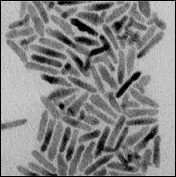Just turn the dial to the color of your choice. That’s what researchers can do when they work with blobs of atoms called quantum dots. If they make small clusters, their creations emit and absorb light toward the blue end of the spectrum. Somewhat larger clusters prefer light toward the red.


Discovered in the early 1980s, quantum dots usually measure less than 10 nanometers (nm) across. They particularly fascinate physicists and physical chemists because the often hidden actors of quantum mechanics take center stage in these clusters.
Lately, it’s become evident that quantum dots may be turned into extraordinary beacons or sponges of light. In 1998, experiments demonstrating that quantum dots can serve as vivid color tags for biomolecules (SN:10/24/98, p. 271) led to the launching of the first quantum-dot commercial venture. Quantum-dot lasers (SN: 11/23/96, p. 327) and extremely sensitive photodetectors have also started to appear.
Another use of dots is attracting interest: generation of electricity from solar energy. “Because the [light] aborption depends on [dot] size, you can try to design the device to have the optimum sensitivity to the solar spectrum,” explains Neil C. Greenham of the University of Cambridge in England. That use would require dirt-cheap production of quantum dust.
Solar-electricity researchers have for decades sought an alternative to the conventional photovoltaic cell. Although sales of conventional cells are booming today and their properties continue to improve, the basic design hasn’t changed in 40 years. Because standard cells are made by exacting methods at high temperature and vacuum, they have always been pricey compared with fossil fuels. Quantum-dot solar cells could offer a low-cost alternative, some solar-energy specialists say.
“Dots are hot,” says Arthur J. Nozik of the National Renewable Energy Laboratory (NREL) in Golden, Colo. With grants from NREL or support from industry or other sources, scientific teams in the United States and England are pursuing projects ranging from merging quantum dots with conventional photovoltaic technology to fashioning dots into a new form of light-sensitive matter.
“We have a long way to go” to reach efficiencies that can begin to compete with today’s solar cells, admits A. Paul Alivisatos of the University of California, Berkeley. “But in priniciple it’s achievable, and we see a path to lead us there.”
Layered material
To make conventional photovoltaic cells, manufacturers build up layers of semiconductor material, usually silicon, and infuse impurities into the layers to impart desired photosensitive and electronic properties. The process creates a boundary called a p-n junction inside the device. Across it, an internally generated electric field develops.
When photons strike the cell, they create electron-hole pairs, as scientists say. The photons bump electrons out of atoms and make them available to flow through the device. The voids left behind in the atoms’ electronic structures flow, too. The movement of these so-called holes carries positive electric charge.
To dislodge an electron, a photon must possess at least a minimum energy known as its bandgap, which is characteristic of a semiconductor. Photons toward the blue end of the visible-light spectrum have shorter wavelengths and more energy than red-light photons do and so can create electron-hole pairs in materials that have a larger bandgap.
The internal voltage across the p-n junction sweeps the electrons and holes in opposite directions because of their opposite charges. The movement both prevents the electrons from recombining with holes and creates an electric current.
Commercial cells typically convert about 15 percent of the energy of sunlight to electricity. In research labs, photovoltaic cells have attained record efficiencies of 25 percent. By creating stacks of p-n junctions in the cells, researchers have pushed the performance to 32 percent.
Dislodged electrons
Quantum dots are also made from semiconductors and, in many ways, behave like the semiconductors in conventional solar cells. A photon with sufficient energy will dislodge an electron from an atom in a dot, generating an electron-hole pair. However, dots differ from ordinary semiconductor material because they occupy so little space that electrons and holes get boxed in, or quantum-confined.
Because of this confinement, an electron or hole liberated by a photon is restricted to a set of energy levels, like the rungs of a ladder, within the quantum dot. The smaller the dot, the wider apart the rungs become and the greater the dot’s bandgap.
“Quantum dots have many wonderful properties that result from quantum confinement,” says Sandra J. Rosenthal of Vanderbilt University in Nashville. Not only can solar-cell researchers select the part of the electromagnetic spectrum that dots respond to, they can choose dot energy levels that optimize the current that flows from the dots into the photovoltaic cell. Moreover, Rosenthal notes, quantum-confined matter soaks up light more efficiently than ordinary light-sensitive matter, such as a photosensitive dye, does.
To develop a competitor to the conventional p-n-junction solar cell, several research groups are experimenting with a jumbled matrix of electrically conducting polymer molecules and quantum dots—”spaghetti and meatballs,” says David Adams of Columbia University. The material could be spun or sprayed onto large surfaces.
Since the mid-1990s, for instance, Alivisatos’ group has been investigating combinations of quantum dots made of cadmium selenide or cadmium sulfide and a plastic known as MEH-PPV.
The plastic absorbs blue and green light, whereas the dots respond to reds. The mixture can take advantage of the full range of the sun’s visible wavelengths, says Greenham, who has collaborated in its development.
At NREL, Nozik and his coworkers are making quantum dots adsorb onto larger nanoparticles of titanium dioxide, a white pigment in paints, toothpastes, and sunscreens. When sunlight hits the quantum dots, titanium dioxide particles capture the electrons that are freed.
Because the pigment particles have been sintered together, they can conduct the electrons from particle to particle to an electrode.
Many other research groups around the world are also experimenting with combinations of cheap, easily mixed photosensitive ingredients to make alternative solar cells. However, they use nanoparticles that are tens of nanometers or more in diameter—too big to exhibit quantum effects.
The limiting factor for almost all these designs, including those with quantum dots, may be the transport of electrons and holes to an electrode. That’s probably what’s keeping the typical efficiency of such cells to no more than a few percent at this point, Greenham speculates.
At Vanderbilt, Rosenthal and her colleagues are experimenting with blends of quantum dots and polymers to which they add carbon-60, or buckminsterfullerene, molecules—popularly known as buckyballs. They expect the buckyballs to improve electron transport. These efficient electron carriers have served the same purpose in other alternative solar cells.
Alivisatos and his team, by contrast, are not adding anything new to their recipe. Instead, the scientists are modifying the quantum building blocks themselves.
When Greenham, Alivisatos, and Xiaogang Peng, who is now at the University of Arkansas in Fayetteville, described their first quantum-dot solar cell in 1996, they reported an efficiency of a quarter percent at a particular wavelength of green light. In the August 1999 Advanced Materials, Peng, Alivisatos, and Wendy U. Huynh, who is also at Berkeley, reported an 8-to-10-fold improvement in the efficiency of their cells by replacing the cadmium selenide dots with nanorods of the same material.
The efficiency boost to 2 percent at a single wavelength comes from better transport, they say. In the earlier cells, electrons had to hop through loose assemblages of dots like someone crossing a stream by jumping from rock to rock. The 13-nm-long rods tend to line up in bridges that are better conduits for electrons. Unlike dots, which confine electrons in three dimensions, these quantum rods confine them in only two and allow them to travel freely lengthwise.
In the March 2 Nature, Alivisatos, Peng, and their coworkers described how they created rod-shaped atom clusters. Alivisatos says that the team is trying to make yet longer rods in the hope of further efficiency gains.
Sue A. Carter of the University of California, Santa Cruz takes a skeptical view of the quantum-dot and quantum-rod efforts, however. She blends semiconducting polymers and sometimes larger nanoparticles, such as titanium dioxide, to make novel solar cells. Carter argues that “quantum dots are exactly the opposite of what you really want” in solar cells. For instance, they put more obstacles in the paths of moving charges because the dots’ high surface-area-to-volume ratios promote particle-trapping surface irregularities.
She points out that the only example of unconventional cells that comes close to competing with standard silicon photovoltaics uses no quantum confinement. Called the Grötzel cell, it runs at about 10 percent efficiency and is starting to be commercialized.
Greenham and other quantum-dot researchers admit that the benefits of confinement are currently “marginal” in solar cells and may never pan out. However, because quantum confinement gives solar-cell designers another way to fine-tune cells, they think the method is worth exploring.
Mark A. Reed of Yale University questions whether quantum dots can be made inexpensively. However, Marcel Bruchez is sanguine about the prospects for low-cost dot manufacturing.
“That is a traditional chemical engineering problem and definitely a tractable problem,” he says. Bruchez is a chemist at Quantum Dot Corp., the new quantum-dot commercial venture cofounded by Alivisatos in Palo Alto, Calif.
Quantum confinement
Whether or not quantum dots enhance cells using photosensitive mixtures, such cells are not the only game in town. At least two scientific teams are pursuing other solar-energy approaches that plainly rely on the power of quantum confinement.
At NREL, Nozik and his coworkers have created a substance of quantum dots in which each of the locations in a crystalline lattice ordinarily occupied by an atom is instead filled by a quantum dot. Weak forces known as van der Waals bonds hold the dots together in these solids.
The dots are small, so their bandgap is large and the gaps between rungs of the dots’ internal energy ladders are big. Because of the lattice arrangement, the high-energy states of the dots merge and run through the whole structure.
Ordinarily, when photons with energies greater than the bandgap strike a light-absorbing material, they generate what scientists call hot electrons, which retain latent energy even after being boosted into the free-roaming state, Nozik explains. That energy usually gets lost as heat while the electrons travel to an electrode.
In the novel material, the pervasive high-energy states could provide a way for hot electrons to retain their latent energy as they travel through the solid. If that energy could be preserved, boosting the cell’s operating voltage, the top efficiency attainable with a single-layer solar cell could leap from the current theoretical limit of 32 percent to an unheard-of 65 percent.
“If some of the ideas we’re pursuing work out, it could be spectacularly successful,” Nozik says. In his next breath, however, he cautions that a practical quantum-dot solid faces many obstacles. “It’s cool on paper, but it’s not so cool in the lab,” he says.
Taking a different tack, a team in England aims to exploit the luminescence of quantum dots to improve solar cells. What makes quantum dots so promising for biological tracing is that they absorb light energy far above their bandgaps but emit light at only one characteristic color. That means that one light source with sufficient energy can excite dots that glow with different colors.
Keith Barnham of the Imperial College of Science, Technology, and Medicine in London, Paul O’Brien of the University of Manchester in England, and their colleagues plan to use quantum dots to absorb a wide range of photon energies from sunlight and then reemit the energy at just a few wavelengths. The researchers envision stacks of maybe three plates of glass or plastic with a different size of dots embedded in each. Sunlight would penetrate to the dots with the smallest bandgap last. Reemitted light would then travel along the layers to emerge at the plate edges. There, the concentrated light would be steered into high-efficiency, conventional solar cells.
Such devices would capture sunlight from all directions and could even absorb energy from diffuse light. The concept dates to the 1970s, but it failed then, Barnham says, because the photoluminescent dyes available at the time were too fragile and too prone to reabsorb their own emissions.
Quantum dots, on the other hand, don’t break down. They also absorb light more efficiently than dyes do. By choosing dot sizes carefully, the team also expects to ensure adequate separation between absorption and emission wavelengths, he says. Efficiencies as high as 20 percent may be attainable with the concentrator, the team reported in the Feb. 28 Applied Physics Letters.
Robert McConnell, head of the NREL office that funds many alternative solar-cell studies, including several involving quantum dots, acknowledges that his projects have only a slim chance of commercial success. However, he says, it’s his job to go out on a limb for scientifically sound but unconventional ideas with a big potential payoff.
Says McConnell,”I try to fund a large number of very good researchers in the hope that a few, even one or two, will deliver a breakthrough.”






